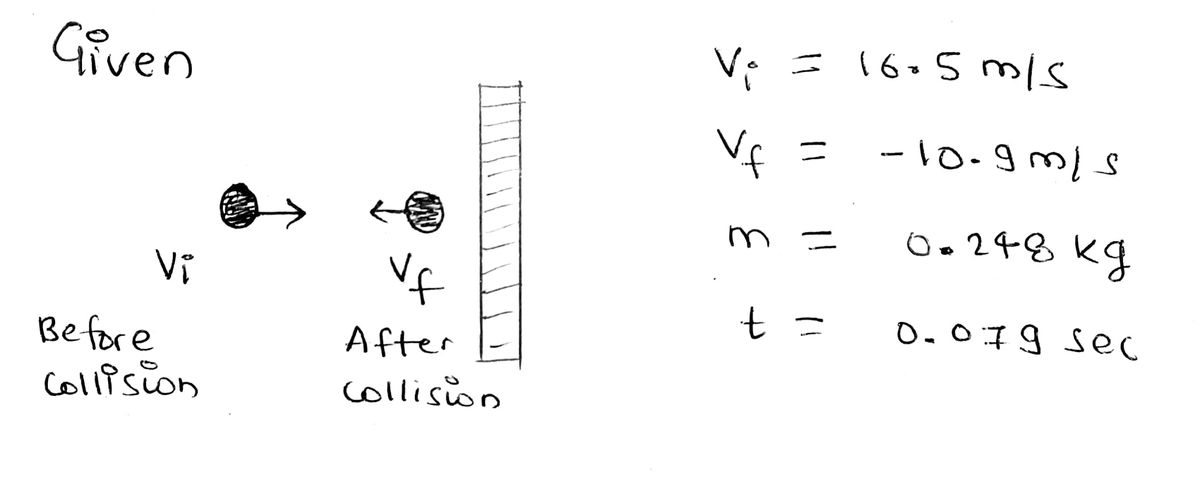A racquet ball with mass m = 0.248 kg is moving toward the wall at v = 16.5 m/s and at an angle of 0 = 31° with respect to the horizontal. The ball makes a perfectly elastic collision with the solid, frictionless wall and rebounds at the same angle with respect to the horizontal. While the ball is in contact with the wall, the average force the wall exerts on the ball has a magnitude of F = 89 N. 1) What is the magnitude of the initial momentum of the racquet ball? 4.092 kg-m/s Submit 2) What is the magnitude of the change in momentum of the racquet ball? 7 kg-m/s Submit + 3) What is the time the ball is in contact with the wall? 0.079 S Submit + 4) Now the racquet ball is moving straight toward the wall at a velocity of vj = 16.5 m/s. The ball makes an inelastic collision with the solid wall and leaves the wall in the opposite direction at vf = -10.9 m/s. The ball is in contact with the wall for the same amount of time as in the elastic collision above. What is the magnitude of the change in momentum of the racquet ball? kg-m/s Submit. + 5) What is the magnitude of the average force the wall exerts on the ball?
A racquet ball with mass m = 0.248 kg is moving toward the wall at v = 16.5 m/s and at an angle of 0 = 31° with respect to the horizontal. The ball makes a perfectly elastic collision with the solid, frictionless wall and rebounds at the same angle with respect to the horizontal. While the ball is in contact with the wall, the average force the wall exerts on the ball has a magnitude of F = 89 N. 1) What is the magnitude of the initial momentum of the racquet ball? 4.092 kg-m/s Submit 2) What is the magnitude of the change in momentum of the racquet ball? 7 kg-m/s Submit + 3) What is the time the ball is in contact with the wall? 0.079 S Submit + 4) Now the racquet ball is moving straight toward the wall at a velocity of vj = 16.5 m/s. The ball makes an inelastic collision with the solid wall and leaves the wall in the opposite direction at vf = -10.9 m/s. The ball is in contact with the wall for the same amount of time as in the elastic collision above. What is the magnitude of the change in momentum of the racquet ball? kg-m/s Submit. + 5) What is the magnitude of the average force the wall exerts on the ball?
College Physics
11th Edition
ISBN:9781305952300
Author:Raymond A. Serway, Chris Vuille
Publisher:Raymond A. Serway, Chris Vuille
Chapter1: Units, Trigonometry. And Vectors
Section: Chapter Questions
Problem 1CQ: Estimate the order of magnitude of the length, in meters, of each of the following; (a) a mouse, (b)...
Related questions
Question
Question 4 and 5, please.

Transcribed Image Text:A racquet ball with mass m = 0.248 kg is moving toward the wall at v = 16.5 m/s and at
an angle of 0 = 31° with respect to the horizontal. The ball makes a perfectly elastic
collision with the solid, frictionless wall and rebounds at the same angle with respect
to the horizontal. While the ball is in contact with the wall, the average force the wall
exerts on the ball has a magnitude of F = 89 N.
1) What
the magnitude of the initial momentum of the racquet ball?
4.092
kg-m/s Submit
+
2) What is the magnitude of the change in momentum of the racquet ball?
7
kg-m/s Submit
+)
3) What is the time the ball is in contact with the wall?
0.079
IS
Submit
4)
Now the racquet ball is moving straight toward the wall at a velocity of vj = 16.5 m/s.
The ball makes an inelastic collision with the solid wall and leaves the wall in the
opposite direction at vf = -10.9 m/s. The ball is in contact with the wall for the same
amount of time as in the elastic collision above.
What is the magnitude of the change in momentum of the racquet ball?
kg-m/s Submit
5) What is the magnitude of the average force the wall exerts on the ball?
N Submit
Expert Solution
Step 1

Trending now
This is a popular solution!
Step by step
Solved in 2 steps with 2 images

Knowledge Booster
Learn more about
Need a deep-dive on the concept behind this application? Look no further. Learn more about this topic, physics and related others by exploring similar questions and additional content below.Recommended textbooks for you

College Physics
Physics
ISBN:
9781305952300
Author:
Raymond A. Serway, Chris Vuille
Publisher:
Cengage Learning

University Physics (14th Edition)
Physics
ISBN:
9780133969290
Author:
Hugh D. Young, Roger A. Freedman
Publisher:
PEARSON

Introduction To Quantum Mechanics
Physics
ISBN:
9781107189638
Author:
Griffiths, David J., Schroeter, Darrell F.
Publisher:
Cambridge University Press

College Physics
Physics
ISBN:
9781305952300
Author:
Raymond A. Serway, Chris Vuille
Publisher:
Cengage Learning

University Physics (14th Edition)
Physics
ISBN:
9780133969290
Author:
Hugh D. Young, Roger A. Freedman
Publisher:
PEARSON

Introduction To Quantum Mechanics
Physics
ISBN:
9781107189638
Author:
Griffiths, David J., Schroeter, Darrell F.
Publisher:
Cambridge University Press

Physics for Scientists and Engineers
Physics
ISBN:
9781337553278
Author:
Raymond A. Serway, John W. Jewett
Publisher:
Cengage Learning

Lecture- Tutorials for Introductory Astronomy
Physics
ISBN:
9780321820464
Author:
Edward E. Prather, Tim P. Slater, Jeff P. Adams, Gina Brissenden
Publisher:
Addison-Wesley

College Physics: A Strategic Approach (4th Editio…
Physics
ISBN:
9780134609034
Author:
Randall D. Knight (Professor Emeritus), Brian Jones, Stuart Field
Publisher:
PEARSON